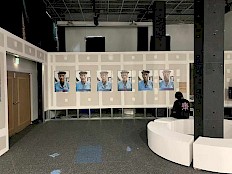|
21.IX.2017
14.I.2018 |
Violence in War and Peace
curated by Guy Schraenen | |
|
According to a commonly repeated story, a German officer asked Pablo Picasso, pointing to a photograph of his Guernica, “Did you do that?” Picasso is said to have replied, “No, you did.” The exhibition Violence in War and Peace is about this “you,” the inhumanity done to men by men that seemingly cannot be cured, not even after the terrible experiences of the most barbaric disasters of the last decades. Violence in War and Peace presents the publications from roughly thirty artists that range from the book Kriegsfibel(1955) by Bertolt Brecht and its “sequel” War Primer 2 (2011) by Oliver Chanarin and Adam Broomberg, to the recent work “Oh God”, He Said, Talking to a Tree (2010) by Walid Raad. Whether the terrifying violence is represented in a brutally direct fashion or through intimate, almost poetic images, all of these works denounce the dreadful threat of terror, the effects of which are, independent of possible causes, of comparable horror for any human being. Violence in War and Peace deals with images of victims—soldiers and civilians alike—wrenched by the barbarity and chaos of catastrophic war and different scenes of violence, such as riots, terrorist acts, or nonviolent demonstrations that are violently repressed. This exhibition deals mainly with artistically appropriated documents or interpretations. In contrast to deadline-driven journalists, art allows a more reflexive way of approaching violent acts. Its strategies for visualizing, revealing, and denouncing violence are countless, ranging from the use of historical photos to concrete poetry. Many of the artists explore the intentions behind the horror and the manipulation of images and words that often play on the attractiveness or even aestheticization of violence —whereby the belligerent parties, be they leftists or rightists, revolutionaries or counterrevolutionaries, democrats or fascists, often employ similar verbal and visual strategies in their propaganda. All together, the chosen publications can be seen as tangible expressions of the eternal use of violence, illustrated by the Optimistic Box No. 1 (Thank God for Modern Weapons) (1968) by Robert Filliou. Once in a while it occurs that a courageous attitude can interrupt those dynamics. Letter to a Refusing Pilot (2013) by Akram Zaatari gives, as the artist states, “a human face” to an individual act of disobedience.
Artists: Julián Barón, Seana Biondolillo, Christian Boltanski, Jean-François Bory, Bertolt Brecht, Oliver Chanarin & Adam Broomberg, Paulo Bruscky, Emily Jacir & Susan Buck-Morss, Chris Burden, Russel Butler, Guillermo Deisler, Club Moral , Felipe Ehrenberg, Amerigo Marras & Bruce Eves, Hans-Peter Feldmann, Robert Filliou, Brad Freeman, Félix González-Torres, Mona Hatoum, Jenny Holzer, Caro & Jeunet, Barbara Kruger, George Maciunas, Miralda, Jaime Narváez, Dámaso Ogaz, Michele Perfetti, Walid Raad, Joan Rabascall, Juan Carlos Romero, Gerrit Jan de Rook, Reiner Ruthenbeck, Matthieu Saladin, Samaral, José Antonio Sarmiento, Gemma Sin, Klaus Staeck, Francesc Torres, Isidoro Valcárcel Medina, Wolf Vostell, Emmett Williams, Akram Zaatari. | ||
|
Thursday 21st of September 2017 -> Sunday 14th of January 2018 in Museo Nacional Reina Sofia, Ronda de Atocha Street, 28012, Madrid, Madrid, Spain. weblink | ||
|
Included works: Related bibliography: | ||
